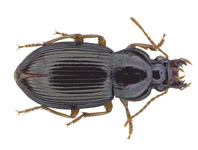Abstract
The generic name Lispirurus Ederli, nom. nov. for Sicarius Li, 1934 (Nematoda, Spirurida), is a homonym of the generic name Sicarius Walckenaer, 1847 (Arthropoda, Arachnida). The genus Sicarius Walckenaer, 1847 was originally erected for spiders, commonly known as six-eyed sand spiders, and contains 25 species, while the genus Sicarius Li, 1934 was erected to include some Habronematinae nematode species, which some of them were transferred to the genus Procyrnea. Thus, actually, the new genus Lispirurus, is composed of a total of 4 species, with L. dipterum as the type species.
References
Aguilar, P.G. & Méndez, M.A. (1971) La "araña chata del nido de arena", Sicarius peruensis (Keyserling), 1880. Características morfológicas y ecológicas. Revista Peruana de Entomologia, 14, 143–156.
Cancrini, G., Balbo, T. & Iori, A. (1991) Su um nuovo Habronematidae parasita di Acryllium vulturinum: Sicarius renatae sp. n. Parassitologia, 33, 133–136.
Chabaud, A.G. (1958) Essai de classication des nematodes Habronematinae. Annales de Parasitologie Humaine et Comparée, 33, 445–483.
ICZN (1999) International Code of Zoological Nomenclature. The International Trust for Zoological Nomenclature, London, 306 pp.
Li, H.C. (1934) Report on a collection of parasitic nematodes, mainly from north China, Part II. Spiruroidea. Transactions of the American Microscopy Society, 53 (2), 174–195.
https://doi.org/10.2307/3222091Magalhães, I.L.F., Brescovit, A.D. & Santos, A.J. (2013) The six-eyed sand spiders of the genus Sicarius (Araneae: Haplogynae: Sicariidae) from the Brazilian Caatinga. Zootaxa, 3599 (2), 101–135.
https://doi.org/10.11646/zootaxa.3599.2.1Quentin, J.C. & Wertheim, G. (1975) Helminthes d'oiseaux et de mammifères d’Israel V. - Spirurides nouveaux ou peu connus. Annales de Parasitologie et Comparée, 50, 63–85.
Sharma, R.K. (1971) A new nematode Sicarius hoopoe n. sp. (Habronematinae) from a bird. Zoologischer Anzeiger, 187 (5–6), 303–306.
Vaz, Z. (1936) Estudos sobre nematóides parasitas da ema (Rhea americana). Archivos do Instituto Biológico, 7, 253–266.

